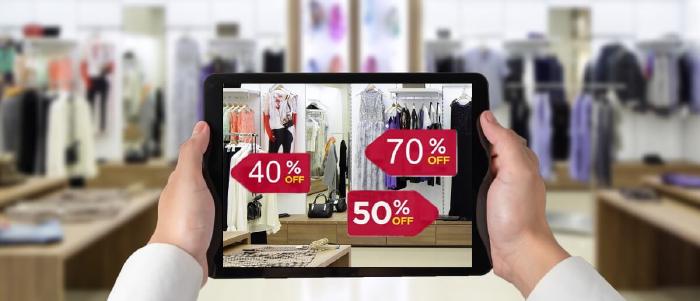
Sep 23 2022
7 min read

Brands that rely on franchise or distributor partners for selling their products face a tough product marketing challenge. Examples of such brands include automobile manufacturers, wholesalers, and FMCG companies.
Effective franchise advertising contributes in creating a strong brand image and increases the likelihood of customers choosing your franchise over others
These brands will often compete in a multi-brand distributor setting where a single distributor sells everything from cut-rate local products to the finest & branded commodities.
That is why, if such manufacturing brands are to make their mark in the market, it is crucial for them to adopt a Point of Purchase (PoP) digital signage strategy.
A Point of Purchase (PoP) is any area within a brick-and-mortar store where the customers can potentially make a purchase.
If you are thinking, “well, that’s like…the entire store”, you are on point.
Theoretically, a PoP is every corner of the store a customer can roam about. But, places like the product shelves, shopping aisles, and the point of sale (PoS) are particularly pivotal. Placing digital signage in these strategic points improves the sales metrics significantly. So, when you strategically use digital signage in your retail point of purchase, especially in these vital in-store areas, there will be noticeable improvement in the sales metrics.
Did You Know: 70% of purchasing decisions are made at the Point of Purchase (PoP)
Source: The Economic Times
The Point of Purchase is incredibly important for any B2C business as it brings the brands and the customers face to face. There are several advantages of marketing your brands and products in the PoP; the following are some of the most compelling ones:

In a multi-brand distributor store, if your brand deploys a digital signage solution, there is a high chance your products will get 5X more visibility than competing brands.
The reason is simple: people tend to retain attractive visuals and dynamic ads more than Sale stickers or static signs.
This is precisely why Pickcel’s Denmark-based client Paralenz adopted a PoP marketing strategy for promoting their underwater camera and gear. Read their success story.
While we discuss what brands can get when they use digital signage for their franchise stores, let me also say what they would miss without it.
Imagine all your signs are being some sort of paper cut-outs or vinyl stickers. How frequently do you think you could update your offers? Daily? Weekly? Perhaps, monthly?
With static signs, most brands cannot make even a teensy bit of change in their marketing and promotional content.
However, when you have a digital signage software to drive dynamic electronic content to digital screens, many opportunities open up. Now, there is flexibility to correct content errors, launch real-time offers nationwide (and even worldwide), and track consumption patterns for better marketing decisions.
Modern-day shoppers shop not only for necessities but also for the experience. That is why your Point of Purchase marketing strategy should always include showing tempting content on digital signage that tickles your customers to spend a little more on impulse.
For supplier brands that do not have their own storefront, the growth of their distributor partners translates to their brand growth.
When you install digital signage at your distributors’ stores, you also make their store experience rich. People enjoy visiting retail outlets that are upgraded with technology.
But beyond that, brands can also rent or share their digital signage space with their franchise partners. Meaning, at specific times, when the brand content is not playing, the distributors can use the screens to show non-competing content like store timings and notices & bulletins.
Better customer experience at your franchise stores means increased store footfall. And that means more eyes to fixate on your product ads & offers.

A retail brand with an in-house sales team can accumulate a lot of intelligence about the customer service and product feedback. But for businesses relying on distributor networks, this intelligence is hard to gather.
But this intelligence is too critical to be missed. In fact, the data that, on a global scale, businesses risk losing $4.7 trillion due to poor customer service may come as an unhealthy surprise.
Manufacturing brands can use their PoP digital signage software to collect feedback from customers and analyze the retailing loopholes.
Here are some of the best ways brands can use digital signage at their franchise stores and distributor outlets.

Showing product ads on the Point of Purchase displays is one thing. But when you get creative, there are more than one ways of tempting shoppers to buy what you sell.
One such way is to sell through a ‘quantity scarcity’ promotion campaign. These campaigns include limited deal offers that can be promoted through interactive digital discount coupons. Interactive discount coupons work with QR codes; shoppers can scan these codes to avail of your offers, and you can track customer engagement in real-time.

In the past years, there has been a steady rise in consumers who prefer self-service over an assisted purchase. If you deploy interactive touchscreen & touchless kiosk solutions at your franchise stores, you can expect 10X more engagement from your target audience.
These kiosks can be designed such that the shoppers can browse through your products and buy them if they will.
On the one hand, it improves your brand image by delivering a personalized customer experience. On the other hand, if your kiosk solution is armed with intelligence, it can also gather data on what products your consumers prefer to browse and buy more.
Starbucks and McDonald’s are two global franchiser brands that have recently spent billions on interactive self-ordering kiosk solutions.
Suggested Read: How Pickcel helped Asian Paints drive massive customer engagement through product marketing on interactive displays.

One of the key marketing objectives for any franchiser brand is to reach local consumers. And a great way to do that is to communicate effectively in regional languages. Many digital signage software support multilingual content playback. For example, your screens can show the local weather or the regional news as infotainment.
In countries like India, with as many as twenty-two official languages and each state having its own regional dialect, multilingual PoP marketing profoundly impacts sales statistics due to the sentimental connection.

While PoP stands for Point of Purchase, PoS refers to the Point of Sale. PoS is the zone where customers make payments and checkout from the store. It also refers to any interface that calculates your customers’ purchases and allows them to make transactions.
So in a way, PoS is an element of PoP. And a rather crucial element for brands with no storefront.
Let’s say your distributor sells three different brands of soda -
Brand A (a popular low-cost brand that sells well)
Brand B (a fine & pricey brand with loyal consumers)
Brand C (your newly-launched brand that is yet to be identified by either of the consumer types)
How do you manage to stand out in the competition?
It may be financially risky (and unreasonable) for you to deploy large-scale digital signage solutions like ad banners, window displays, or similar.
However, your brand can afford to install small tablets at the billing counter near the point of sale. That’s where you say that your soda is caffeine-free, Sugar-free, and regret-free.
Believe it or not, real product marketing takes off at the PoS, where your customers are already reaching for their wallets. In terms of buyer psychology, shoppers are more inclined to buy a new product as an add-on near the billing window.

Let’s recall the definition of PoP once: any space in the retail store where your customers can potentially make a purchase. But I did miss saying that PoP can be a virtual space too.
Brands can make sure their customers get constant access to their product inventories. One way to do that is to add a QR code to your PoP digital signage.
Your franchise store customers can scan the QR codes with their mobile phones and land on your product inventories or digital product catalogs. Meaning, that while your competitors restrict their marketing to limited spaces inside the store, you allow your call-to-action to be portable.
The result?
An omni-channel presence of your brand ensuring more sales.
Point of Purchase advertising through digital signage can help any brand obtain, engage, and retain customers. However, there are certain product segments where PoP marketing takes center stage.
Here are some examples:
**Products primarily driven by impulse buying:** chocolates, candy, toys, magazines, stationeries.
**Brands where advertising mediums are limited:** Liquor, tobacco, and marijuana, which are prohibited from advertising in some media.
**Products where visual appeal impacts the purchase decision:** cosmetics, home furnishing & bathroom fittings, food, gift items
**Goods & commodities that need clear specification of details:** Automobiles, electronic gadgets, over-the-counter medicines & supplements
Your Point of Purchase is the best place to establish yourself as a brand. And this where your marketing efforts should concentrate. There are innovative ways in which brands can optimize digital signage to convert customers.
It is important that you choose a powerful digital signage software for your screen network, one that will allow you to publish your content remotely, integrate your digital signage with internal servers, and distribute targeted content through custom tags like language, location, and franchise partner.
Schedule a demo with Pickcel today and deploy the most effective PoP digital signage solution for your franchise network.

Sep 23 2022
7 min read
![What are 3D digital billboards for advertising? [5 Examples]](/blog/images/3d-advertising-billboard/banner_hu3a52995533a2f5f6af3321531a883f0d_86539_700x0_resize_q75_box.jpg)
Sep 8 2022
6 min read

Sep 6 2022
9 min read

Aug 18 2022
6 min read
Take complete control of what you show on your digital signage & how you show it.
Start Free Trial Schedule My DemoSee How Amazon Solved Retail Marketing Challenges – Boosted Sales & Conversions by Almost 27%
Unlock Exclusive Insights